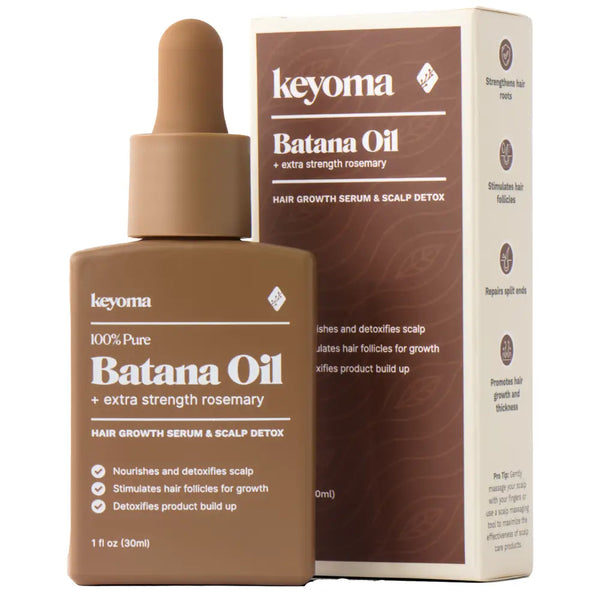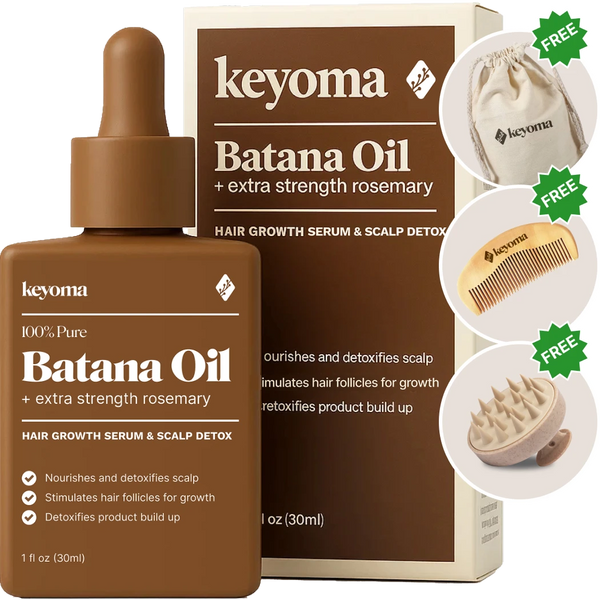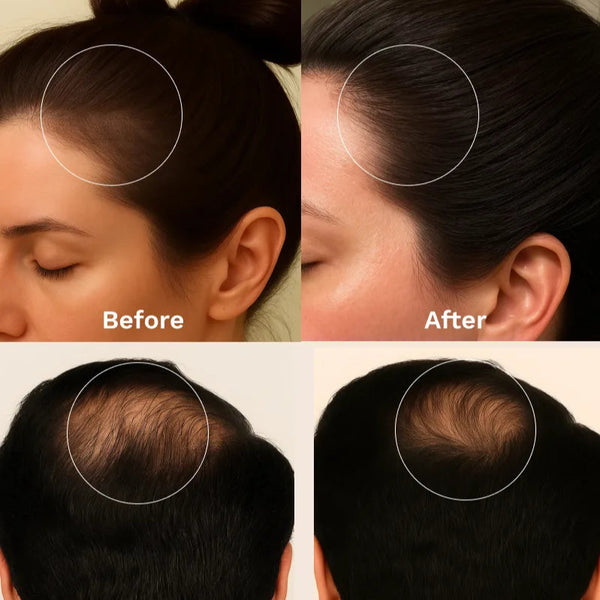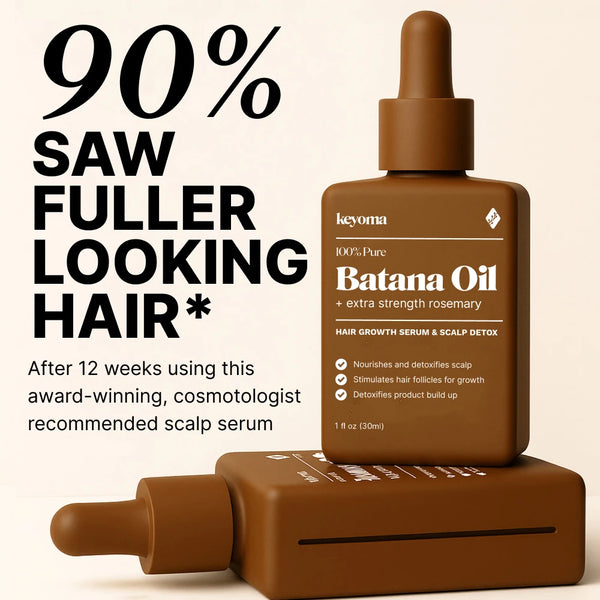In this article
Signs of aging show up differently for everyone, and hair loss is no exception. You might see thinning on the crown or a bald spot in back. Others notice change in front as the hairline recedes, especially around the temples. Temple thinning is usually not a medical emergency, but that does not make it easy to accept.
From causes and treatments to prevention, keep reading to learn what experts say about thinning hair at the temples.
Key Takeaways
-
Temple hair loss means thinning near the hairline; men and women experience it.
-
Common causes include androgenetic and traction alopecia, telogen effluvium, and frontal fibrosing alopecia.
-
Whether loss is permanent depends on cause; early treatment may restore some density.
-
Massages, plant oils, nutrition changes, and looser styles may support regrowth.
What Is Temple Hair Loss?
Temple hair loss refers to thinning and shedding along the temples that can create visible bald patches over time. Studies show this pattern is most common in males ages 18 to 50.
In that group, 60.3% reported severe hair loss while 50.4% had baldness. Stress, genetics, frequent use of styling products, and tight hairstyles can all play a role. Your first step toward stopping or reversing temple loss is to identify the underlying cause.

Causes of Temple Hair Loss
Temple thinning often signals broader hair loss patterns. Androgenetic alopecia, traction alopecia, and telogen effluvium can make follicles break or pause growth. Frontal fibrosing alopecia is another possibility. It is less common, often linked with eyebrow thinning, and can lead to permanent follicle damage that prevents regrowth.
Can Temple Hair Loss Be Permanent?
It depends on the cause. Some conditions are temporary — telogen effluvium, for example, often resolves on its own. Androgenic alopecia and traction alopecia tend to worsen over time without treatment.
Even though androgenic alopecia can be permanent, early treatment may bring back some density. Hair lost a year ago, however, is unlikely to return.
Alopecia areata can also result in permanent loss, but quick treatment might slow progression.
To avoid permanent temple thinning, see a healthcare professional as soon as you can. They can pinpoint your hair loss type and walk you through the best options.
Symptoms of Hair Loss at the Temples
While you can lose up to 100 hairs per day through normal shedding, thinning is often an early warning sign. You may see more hair in the drain or brush. A receding hairline also points to hair loss and can extend into the temples.
Temple loss can create a widow’s peak, the V-shaped hairline more common in men but possible in women too.

How to Prevent and Treat Temple Hair Loss
If genetics drive your hair loss, you cannot fully prevent it, but you can reduce its impact and learn how to support growth at the hairline.
1. Scalp Massage
A daily scalp massage is a simple way to encourage natural regrowth, especially in delicate temple areas.
Spend 5 to 10 minutes a day massaging to boost circulation, which delivers oxygen and nutrients to follicles.
This stimulation can lengthen the growth phase and wake up dormant follicles.
Consistency matters. Over time, regular massage can help temple hair look fuller.
2. Natural Oils
Certain plant oils can support hair health and address temple thinning.
Rosemary oil is known for improving circulation and stimulating follicles to encourage growth.
Rosehip oil, rich in antioxidants and essential fatty acids, nourishes the scalp and supports healthy skin near the hairline.
Olive oil offers deep moisture and strength, while marula oil provides light hydration and shields against environmental stress.
Massage a small amount into the temples and leave it on for at least 30 minutes, or overnight, before rinsing.
3. Adjust Your Diet
A shortfall of key nutrients can lead to hair loss. For instance, shedding is a common sign of iron deficiency anemia, which can develop if you do not get enough iron in your diet.
Add iron-rich foods like:
-
Cereal fortified with iron
-
Dried beans
-
Dried fruits (i.e., apricots, prunes, and raisins)
-
Eggs
-
Lean red meat
-
Liver
-
Oysters
-
Salmon
-
Tuna
-
Whole grains
Vitamin C improves iron absorption, so pair iron-rich foods with citrus, potatoes, strawberries, or tomatoes.
Research links low protein intake with a higher risk of hair loss. Add protein sources like beans, meat, fish, tofu, and low-fat dairy.
Talk with a healthcare provider before starting supplements. A blood test can identify any nutrient gaps.
4. Natural Remedies
To encourage temple regrowth naturally, try these options:
-
Batana Oil: I personally like this because a few drops feed the scalp with fatty acids, and my friends notice less breakage and fuller-looking temples with regular massage.
-
Olive Oil: This natural emollient nourishes the scalp and can improve blood circulation when massaged gently.
-
Aloe Vera: Known for its soothing properties, aloe vera helps to restore the pH balance of the scalp and promotes hair growth.
-
Onion Juice: Applying onion juice can be beneficial due to its sulfur content, which aids in increasing collagen production and stimulating hair follicles.
-
Coconut Oil: Massaging warm coconut oil onto the scalp can strengthen hair follicles and prevent breakage while also promoting new growth.
-
Honey, Cinnamon, and Olive Oil Mixture: A combination of these ingredients can create a potent hair mask that nourishes the scalp and promotes regrowth.
-
Neem Leaves: Neem leaves possess medicinal properties that help in treating various scalp conditions, thus promoting healthy hair growth.
-
Green Tea: The antioxidants in green tea help in preventing hair loss and promoting regrowth by inhibiting DHT, a hormone associated with hair loss.
-
Potato Rinse: Boil potato peels, use the water as a rinse after shampooing to restore lost nutrients and encourage healthy hair growth.
5. Avoid Tight Hairstyles
Constant tension on the hairline can cause traction alopecia, a pattern that commonly shows up at the temples.
Tight ponytails, braids, buns, and headbands place ongoing stress on hair shafts and follicles, which can lead to gradual thinning or permanent damage if you do not change the habit.
Heat tools, harsh chemicals, and rough brushing can weaken strands over time as well.
Protect your temples by wearing loose styles, skipping heavy products, and using gentle detangling methods.
Giving your hair a break from aggressive styling lets weakened follicles recover and may support natural regrowth.
Support Temple Regrowth With Massage and Keyoma Pure Batana Oil
Temple thinning can happen to anyone and often comes from genetics, styling habits, or broader hair loss patterns. You may see a receding hairline or a widow’s peak, and the course can be temporary or progressive depending on the cause. While it is not usually urgent, it can change how you feel about your hair.
Build a routine you can keep, track changes with photos, and ask for help if shedding continues. For a simple addition to scalp care, you can work a few drops of Keyoma Pure Batana Oil into your temples during massage. With steady care and the right guidance, you can protect fragile areas and support healthier growth over time.
Featured Product
100% Pure Batana Oil + Rosemary
↓Best Batana Oil to Buy↓
1 Month
Subscribe & Save
- 30-day supply delivered monthly $35
- 30% off for life $6
- Free haircare essentials kit $33
- Free custom wooden comb $10
- Free scalp massager $15
- Free eco-friendly travel bag $8
- 30-Day Money Back Guarantee
- Free Shipping
- Online portal for easy cancel, skip, or pause.
1 Month One Time Purchase

- 30-day supply $50
- 30% off for life $6
- Free haircare essentials kit $33
- Free custom wooden comb $10
- Free scalp massager $15
- Free eco-friendly travel bag $8








